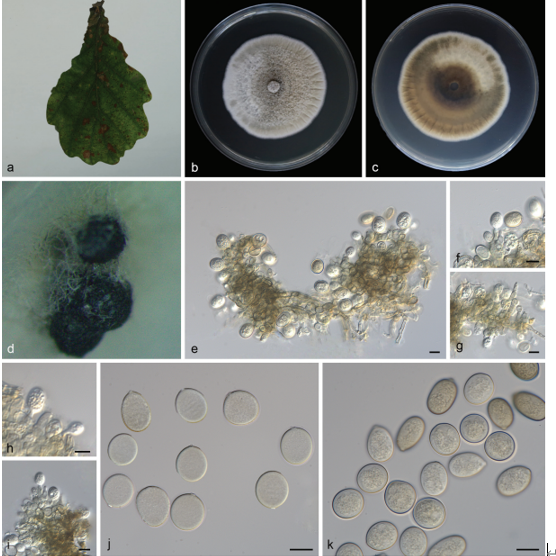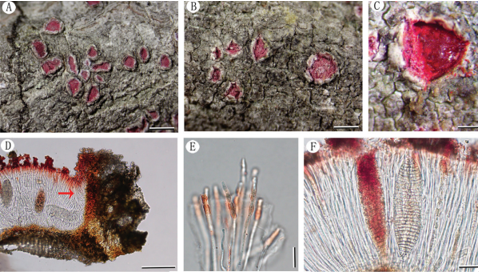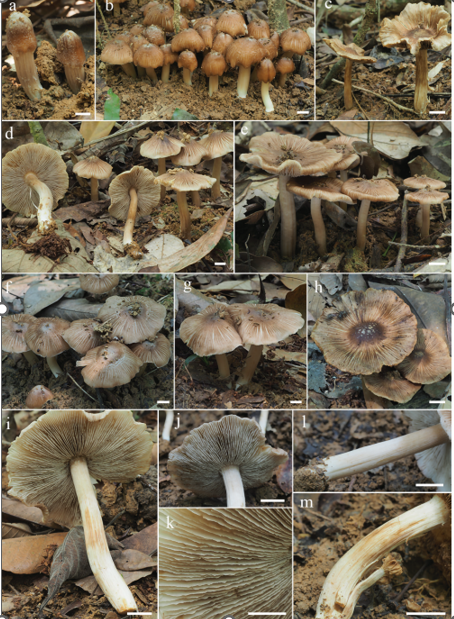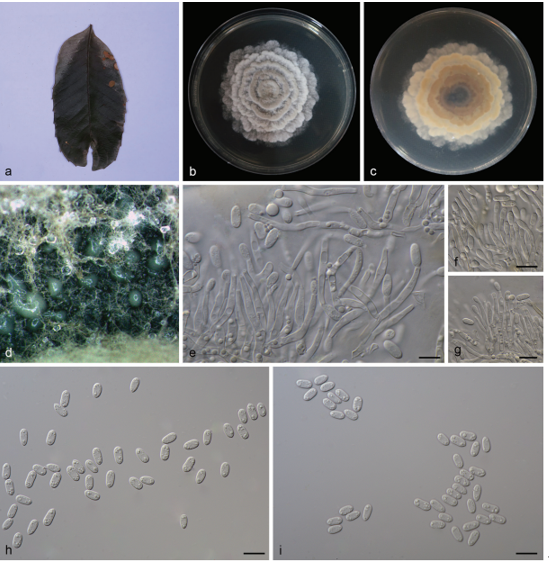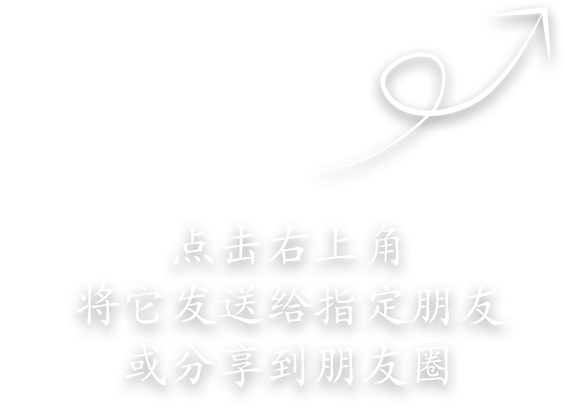Atheniella taoyao Q. Na & Y.P. Ge, sp. nov. 2021
MycoBank No: 839380
Holotype: China. Yunnan Province, Yuxi City, Xinping County, Mopanshan Na tional Forest Park, 25 Jul 2020, Qin Na, Yupeng Ge and Zewei Liu, FFAAS0352 (Col lection No. MY0184).
Morphological description
Sexual morph: Pileus 1.4–5.8 mm in diam., campanulate or hemispherical, obtuse ly umbonate in the centre, flattening with age, translucent-striate, light pink-salmon, light coral red, fading light pink or white to the margin, delicately pubescent, glabrescent with age, with a flat margin. Context pure white, thin, fragile. Lamellae decurrent dentate, ascending, sparse, pure white, edges concolorous with the sides. Stipe 46–58 × 0.5–1.0 mm, central, terete, almost equal, hollow, fragile, trans parent, pruninose, glabrescent with age, base slightly swollen, with tiny, white, fine hairs. Odourless, taste mild.
Basidiospores [80/4/3] (7.4) 7.7–8.3–9.1 (9.4) × (3.9) 4.1–4.5–5.0 (5.5) μm [Q = 1.73–2.08, Q = 1.85 ± 0.076] [holotype [40/2/1] (7.4) 7.7–8.2–9.0 (9.2) × (4.0) 4.1–4.4–5.0 (5.4) μm, Q = 1.75–1.99, Q = 1.84 ± 0.079], narrowly ellipsoid to cy lindrical, hyaline, guttulate, thin-walled, inamyloid. Basidia 20–31 × 5–7 μm, hyaline, clavate, 2-spored. Cheilocystidia 23–42 × 5–10 μm, fusiform, long-stalked, hyaline. Pleurocystidia similar to cheilocystidia, 20–40 × 5–9 μm. Pileipellis hyphae 1–5 μm wide, cutis; covered with numbers of cylindrical or fusiform excrescences, 3.5–10.4 × 1.4–4.3 μm, hyaline. Hyphae of the stipitipellis 3–10 μm wide, hyaline, smooth; caulocystidia fusiform, 16.5–24.9 × 5.3–11.5 μm or subglobose, 11.8–16.5 × 9.1 12.9 μm. All tissues non-reactive in iodine. Clamps not seen.
Asexual morph: Undetermined
Culture characteristics:
Habitat: Scattered to gregarious on living wood in evergreen broadleaf forest, for example, Cephalotaxus, Cunninghamia.
Distribution: China
GenBank Accession:
ITS Sequences ID MW969655; nLSU Sequences ID –
ITS Sequences ID MW969656; nLSU Sequences ID MW969666
ITS Sequences ID MW969657; nLSU Sequences ID MW969667
Remarks: Atheniella taoyao is unique in Atheniella because of the light pink-salmon pileus, decurrent lamellae and the two types of caulocystidia. Atheniella adonis most closely resembles A. taoyao, but the former differs in having adnate to adnexed lamellae, stipe with pink at the apex and larger caulocystidia (15–50 × 3.5–13.5 μm) (Aronsen and Læssøe 2016). Atheniella amabillissima is closely allied to A. taoyao, but differs in the larger basidiomata (pileus 3–20 mm in diam.), pileus fading to white or yellow with age, stipe tinted with coral red and yellow with age and the cheilocystidia are up to 65 μm in length (Smith 1935b). Aravindakshan and Manimohan (2015) described the species Mycena rohitha Aravind. & Manim. (≡ Atheniella rohitha) collected from India. T his taxon differs from Atheniella taoyao in its orange stipe and gelatinous pileus hy phae (Aravindakshan and Manimohan 2015). Mycena wubabulna, a species described by Grgurinovic (2003) that should be transferred to Atheniella, is readily identified by its yellowish stipe base and cylindrical basidiospores (7.5–10.6 × 3.1–4.7 μm; Q = 2.3).
Reference: [1] Ge, Y. , Liu, Z. , Zeng, H. , Cheng, X. , & Na, Q. . (2021). Updated description ofatheniella(mycenaceae, agaricales), including three new species with brightly coloured pilei from yunnan province, southwest china. MycoKeys, 81, 139-164.
Figure 2. Basidiomata of Atheniella species q–s Atheniella taoyao Q. Na & Y.P. Ge. Scale bars: 5 mm
Figure 7. Microscopic features of Atheniella taoyao (FFAAS0352, holotype) a–c basidiospores d basidia e cheilocystidia f, g pleurocystidia h pileipellis i stipitipellis. Scale bars: 10 μm (a– i). 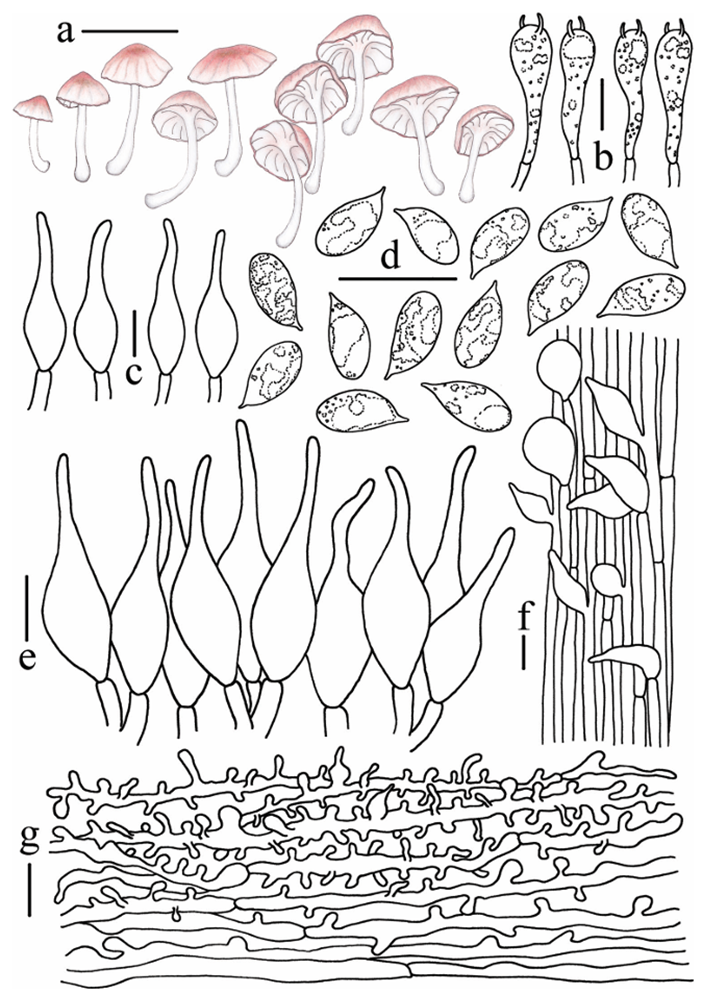
Figure 8. Morphological features of Atheniella taoyao (FFAAS0352, holotype) a basidiomata b basidia c pleurocystidia d basidiospores e cheilocystidia f stipitipellis and caulocystidia g pileipellis. Scale bars: 5 mm (a); 10 μm (b–g). Drawingsby Qin Na and Yupeng Ge.


